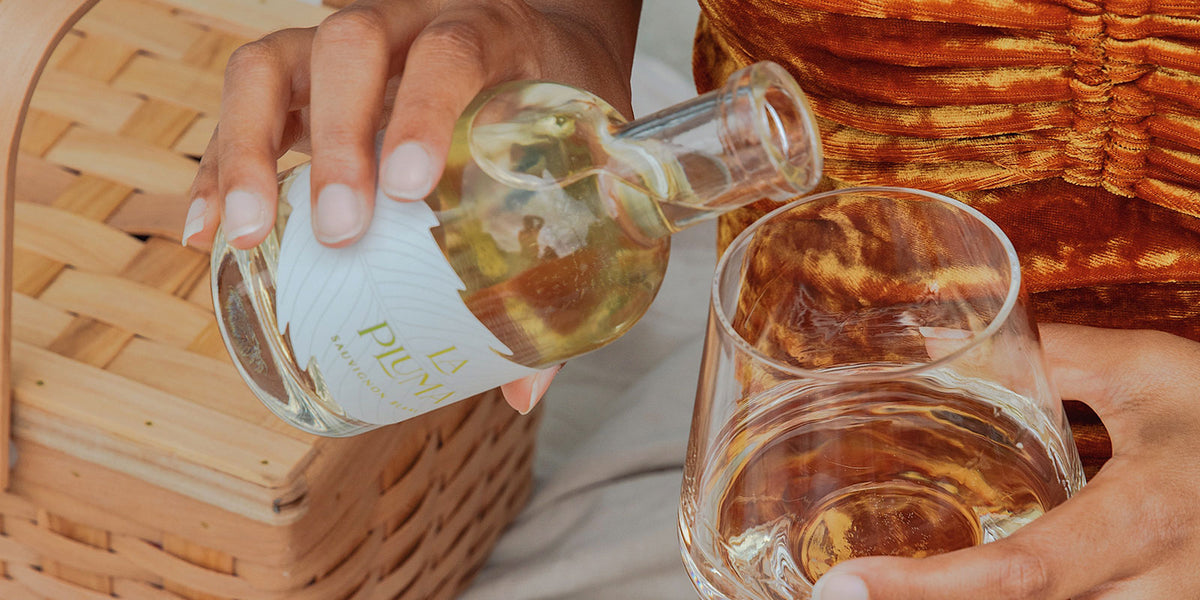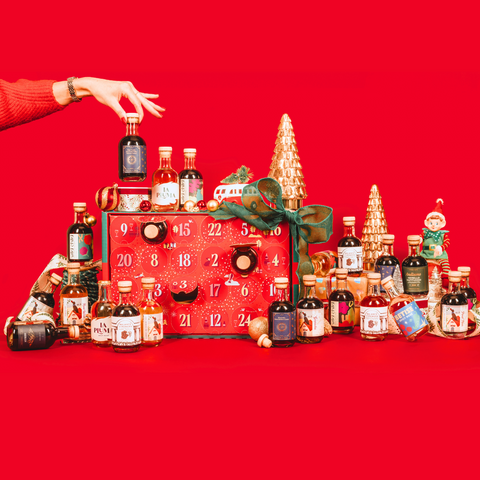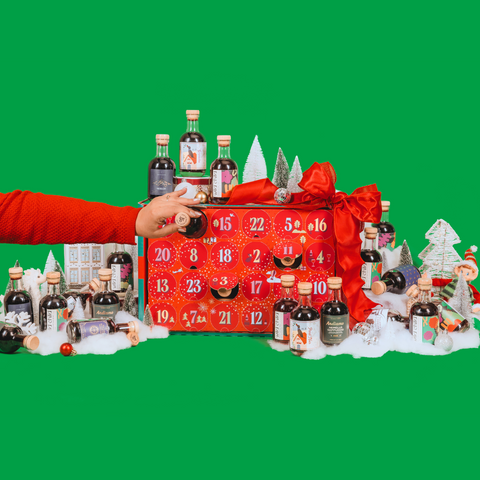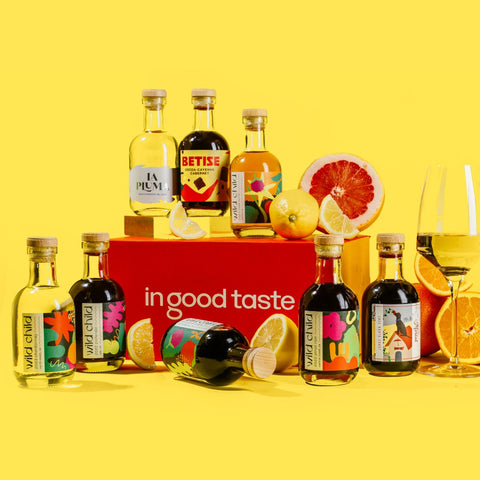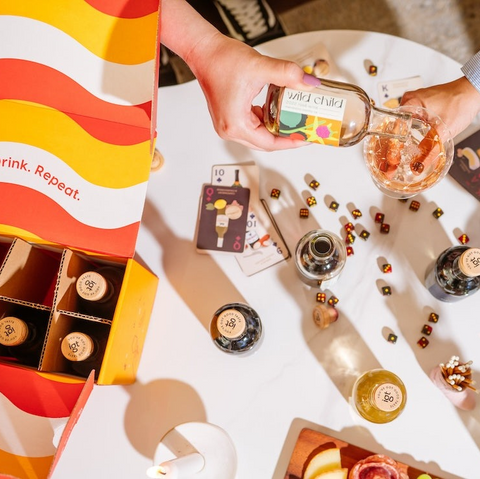The Basics of White Wine
When it comes to wine, many people assume that choosing a favorite simply involves picking a color: red or white. The red and white distinction makes a great starting point for selecting a wine, but it’s just that—a starting point. To truly enjoy the wine experience, you owe it to yourself to go deeper.
If you already know that you like white wine, you might be wondering which you like best. Do you prefer dry white wine, or is sweet white wine your top choice? Do you prefer the buttery vanilla notes imbued from a barrel-aged wine, or the clean and crisp flavors from stainless steel aging? If you already have a favorite, perhaps you want to discover a new wine or two. Maybe you’re trying to find the perfect pairing for grilled chicken. Or glazed salmon. Or that charcuterie board you spent hours preparing. Whatever your reasons for wanting to learn more, we’ve got you covered. This article will help you learn more about the most popular white wines and find the one (or ones) that’s perfect for any moment.
White Wine Production
While wines can be incredibly complex, the winemaking process is relatively simple. Grapes are grown, harvested, pressed, fermented, bottled, and aged. So if that’s all there is to it, the main difference between red and white wine must be in the grapes that are used, right? Yes—and no.
Red wine is made with red grapes, and most white wine is made with white grapes. Wait. Most? Yep, since white wine is traditionally made by removing the grape skin and seeds before the fermenting step, it’s entirely possible to make white wine from red grapes (Hello, Pinot Grigio). But since red grapes have a very different flavor profile than their white counterparts, most white wine comes from white grapes.

Beyond the grapes themselves, the most noticeable production difference happens during the fermentation step. Grapes contain natural sugars, and when eaten and fermented by added yeast, these sugars produce flavors that are consistent with the fruity, floral profile commonly associated with white wine—unless they’re exposed to oxygen. Oxygen is sugar’s natural enemy! OK, OK, it’s not that extreme, but oxygen exposure does remove much of the grapes’ natural freshness and fruitiness. (Good for red wine. Bad for white wine.) To preserve the distinctive aromatics of white wine, winemakers often limit oxygen exposure by fermenting the wine in stainless steel vats.
Of course, there are notable exceptions to this rule. Some white wines, like oaked Chardonnay, are aged in oak barrels to achieve a specific flavor profile that wouldn’t be possible in a stainless steel container. Some wines, like some people, just have to be different.
What is “Body”?
If you’ve ever tasted wine with a group, you’ve probably heard someone talk about a particular wine’s “body.” And if you’re like most people, you probably took a sip, nodded your head knowingly, and responded with an insightful “Mmhmm.” Wine is a liquid. How can it have body? Fair question.
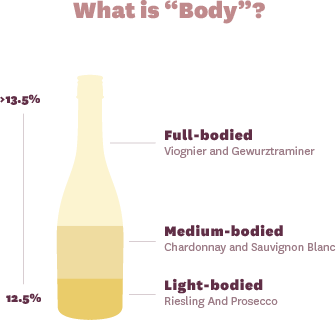
Body is a term used to describe how a wine feels in your mouth. As a general rule, a wine’s body is determined by its alcohol content. The higher the alcohol content, the heavier it will feel in your mouth. To keep things simple, most people talk about wine in three categories: light-bodied, medium-bodied, and full-bodied.
Light-bodied white wines are crisp and bright. Usually with an alcohol level under 12.5%, these wines offer a burst of flavor but don’t feel thick or heavy as you drink. Examples include: Riesling and Prosecco.
Medium-bodies white wines usually have an alcohol content ranging between 12.5% and 13.5%, and they’re often described as smooth and refreshing. Examples include: Chardonnay and Sauvignon Blanc.
Full-bodied white wines inspire descriptions of rich and complex, and they feature the highest alcohol content, coming in at 13.5% or above. Examples include: Viognier and Gewurztraminer.
What is Acid?
Although it sounds more like a science project than a flavor characteristic, acidity brings wine to life, giving it much of its delightful complexity. (And let’s be honest, as far as science projects go, winemaking is easily one of the coolest.)


Wine’s acidity is determined mainly by the type of grape used to make it. Grapes with longer growing seasons in warmer climates produce more sugar, which means their acid level is lower. Grapes with shorter growing seasons—or those harvested before they fully ripen—have higher acid levels.
Acidity gives the wine its crisp tartness, a quality some refer to as the “pucker factor.” In much the same way that biting into a lemon slice makes your taste buds come alive and salivation occurs, the acidity of wine shapes your overall taste experience and highlights other flavors.
Popular White Wine Grapes
Knowing about wine’s body and acidity can help you discover which white wines you enjoy the most. Understanding the kind of grapes used to make each wine will help you feel more confident when you’re trying to choose the best wine for your next big occasion—or a typical Tuesday night.
Sauvignon Blanc
Tasting notes: grapefruit, lime, tropical fruit, peach, honeydew, green pepper
Grown in vineyards around the globe, from the Loire Valley region of France to California and New Zealand, Sauvignon Blanc produces flavorful wine that is dry and refreshing — but different based on where it’s grown. While French varietals, sometimes called Sancerre, tend to be more herbaceous and floral, California-grown grapes can produce a much richer variety with notes of peach.
Chardonnay
Tasting notes: lemon, honeydew, peach, apple, golden pear
One of the most popular grapes in the world, chardonnay grows in a variety of regions. The location influences its flavor qualities, which is why California- and Australia-grown chardonnay exhibits tropical fruitiness while Burgundy-grown chardonnay boasts an apple flavor tinged with a mineral essence. Often fermented in oak, chardonnay picks up a rich, buttery flavor as it ages in the barrels.
Pinot Gris (Grigio)
Tasting notes: fuji apple, peach, mandarin orange, pear
Primarily grown in Oregon and Washington, Pinot Gris brings life to any occasion. Its bright, fruity pear flavor pairs well with just about any dish. Oregon-grown grapes feature a medium body that complements light meats ranging from roasted turkey to grilled chicken. Grapes grown in Washington provide a fuller-bodied white wine with a slightly more tart flavor that goes with just about any seafood dish you can find.
Riesling
Tasting notes: tangerine, peach, apricot, melon, grapefruit, petrol
Ranging from syrupy sweet to crisp, dry and stony, Riesling varietals offer some of the most diverse flavors of a single white grape. With the most renowned grapes grown in Mosel/Rhine, Germany, and Alsace, France. Thanks to global popularity that has grown through the centuries, quality Riesling can also be found in Washington, New York, and even Australia.
Viognier
Tasting notes: apricot, melon, citrus, white pepper, nectarine, florals
Similar to Riesling, these grapes from Rhone Valley grow well in the sun-kissed climates of Australia, Washington, California. When allowed to ripen fully, viognier grapes create a full-bodied, aromatic wine with luscious fruit flavors that can include hints of peach and citrus. Interestingly, like Chardonnay, Viognier is often oak-aged to add richness to the wine.
How Should You Serve White Wine?
Now that you’ve picked the perfect white wine for your occasion, it’s time to think about how you’ll serve it. Sure, red plastic cups and trendy insulated tumblers have their place. (Summer cookouts and pool parties, to be exact.) But if you want to serve your wine in a way that adds a sense of style and reveals your wine’s full range of flavors, you need to pay attention to three key factors: glass, temperature, and tasting.
White Wine Glasses Make a Difference
White wine is best served in a traditional wine glass. What’s a traditional wine glass, you ask? It’s a tulip-shaped glass that features a narrower bowl and a smaller opening than red wine glasses. This design helps preserve the fruit flavors of white wine by keeping it at the optimal temperature for longer—which brings us to the second key to proper white wine service.

What’s the Best Temperature for White Wine?
As a general rule, white wine should be served slightly chilled. Serve light, crisp whites like Riesling and Pinot Grigio at 40° to 50° F to highlight their fresh, fruit-forward qualities. For fuller-bodied Chardonnays and Viognier, serve them between 50° to 60° F to bring out their complex aromas and rich textures.

How to Drink & Enjoy White Wine
Wine tasting sounds pretty straightforward. You sip and see what flavors stand out, right? Well, yes — but there’s more to it than that. To fully appreciate the white wine in your glass, you’ll need to use all five of your senses. Or as we like to say: See. Swirl. Smell. Sip. Savor.
Simple Steps To Taste White Wine





Start by looking at the bottle’s label to see your wine varietal and vintage. Then, when it’s poured into your glass, take a moment to look at the wine’s color and clarity. (Good wine should always be colorful and clear. Cloudy wine may be a signal that something in the winemaking process has gone a little sideways.)
Next, swirl the glass to aerate the wine and release its delicate aromas (and to look fancy in front of your friends, but that’s just a bonus perk).
As the wine settles in the glass, bring it to your nose, inhale deeply, and see if you can identify hints of fruit or spice. With the aromatics setting the stage, you’re finally ready to taste your wine.
Start by taking a small sip and swishing it around in your mouth, making sure to let it wash over every part of your tongue so that you can experience the full range of sweetness, crisp acidity, and alcohol warmth. Don’t rush through the savoring; it’s the step that will help you learn what qualities you like most in your wines.
White Wine & Food Pairings
What Should You Serve With White Wine?
Some people like to drink their wine all by itself. Others like to pair it with food. That’s the beautiful thing about white wine; it’s perfect for any preference. Now, if you’re someone who’s always been in the first group—the purists, we’ll call them—there’s a good chance you haven’t tried pairing your wine with food because you’re not sure what foods go with which wines. We get that. Some wine experts dedicate their entire careers to the art of wine pairing, so the prospect of picking the perfect food for your white wine can feel a little intimidating. Fortunately, a little knowledge goes a long way. If you want to expand your wine pairing palette, here are a few simple tips to get you started.
Appetizers: If you’ll be sipping along with savory foods (like hors d'oeuvres or that charcuterie board we mentioned earlier), off-dry Riesling’s light sweetness provides a delightful balance. Opting for salty snacks like pretzels, crackers, and cheese, Pinot Grigio is the way to go.
Poultry: Whether you’re cooking for yourself or a houseful of guests, main dishes like turkey and chicken are usually a safe bet. To balance the meat’s naturally mild flavor, pair it with a rich, buttery Chardonnay. Serving a spicier dish like Thai chicken or chicken tacos? A full-bodied Viognier can be the perfect companion.
Seafood: If you are dining on shellfish or light, flaky fish like haddock or tilapia, a nice glass of Sauvignon Blanc will provide a fresh, citrus accent. Opting for something more substantial like salmon or swordfish, offset their bold flavor with a sweet Riesling or dry Chardonnay.
Do White Wines Age Well?
We’ve all heard the saying, “aging like a fine wine,” so it’s tempting to think this applies to all wines. In truth, only 1% of all wines vinted will actually improve with 5-10 years of aging, and most wines worth investing in for the purpose of aging are red wines.
The main reason reds age so well is that they are fermented with their skins and seeds, which provide tannins and increased acidity. Over time, these natural additives cause the red wine’s full, robust flavors to mature.
Unlike those big, bold reds, white wine is fermented without grape skins or seeds. This difference highlights the grape’s natural sweetness and fruit flavors, but it also means that most white wines tend to be at their best within the first couple of years after they’re bottled. So if you’re wondering how long you should wait before drinking that bottle of white wine that’s sitting on your rack, we’ve got four words that you’re going to love: The sooner, the better!

